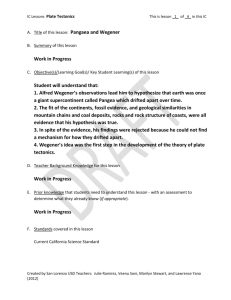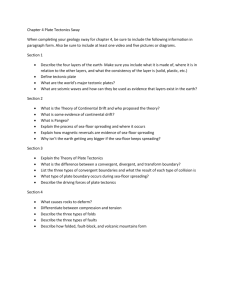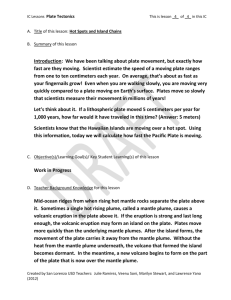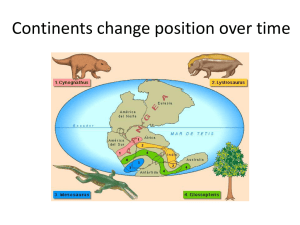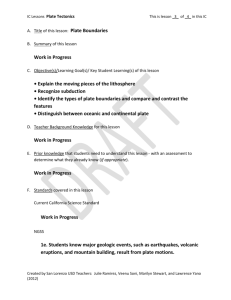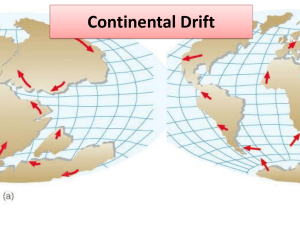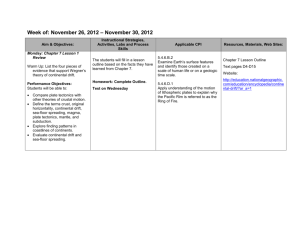Work in Progress
advertisement
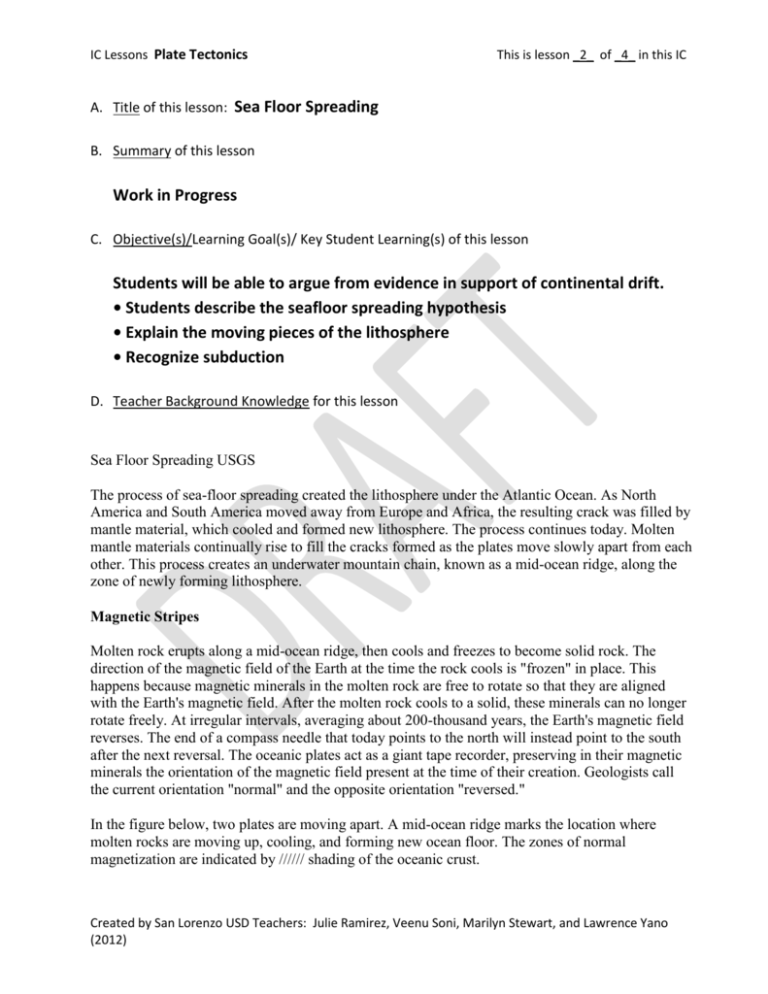
IC Lessons Plate Tectonics This is lesson _2_ of _4_ in this IC A. Title of this lesson: Sea Floor Spreading B. Summary of this lesson Work in Progress C. Objective(s)/Learning Goal(s)/ Key Student Learning(s) of this lesson Students will be able to argue from evidence in support of continental drift. • Students describe the seafloor spreading hypothesis • Explain the moving pieces of the lithosphere • Recognize subduction D. Teacher Background Knowledge for this lesson Sea Floor Spreading USGS The process of sea-floor spreading created the lithosphere under the Atlantic Ocean. As North America and South America moved away from Europe and Africa, the resulting crack was filled by mantle material, which cooled and formed new lithosphere. The process continues today. Molten mantle materials continually rise to fill the cracks formed as the plates move slowly apart from each other. This process creates an underwater mountain chain, known as a mid-ocean ridge, along the zone of newly forming lithosphere. Magnetic Stripes Molten rock erupts along a mid-ocean ridge, then cools and freezes to become solid rock. The direction of the magnetic field of the Earth at the time the rock cools is "frozen" in place. This happens because magnetic minerals in the molten rock are free to rotate so that they are aligned with the Earth's magnetic field. After the molten rock cools to a solid, these minerals can no longer rotate freely. At irregular intervals, averaging about 200-thousand years, the Earth's magnetic field reverses. The end of a compass needle that today points to the north will instead point to the south after the next reversal. The oceanic plates act as a giant tape recorder, preserving in their magnetic minerals the orientation of the magnetic field present at the time of their creation. Geologists call the current orientation "normal" and the opposite orientation "reversed." In the figure below, two plates are moving apart. A mid-ocean ridge marks the location where molten rocks are moving up, cooling, and forming new ocean floor. The zones of normal magnetization are indicated by ////// shading of the oceanic crust. Created by San Lorenzo USD Teachers: Julie Ramirez, Veenu Soni, Marilyn Stewart, and Lawrence Yano (2012) IC Lessons Plate Tectonics This is lesson _2_ of _4_ in this IC The figure below shows the observed magnetic pattern along the mid-Atlantic Ridge south of Iceland. This figure is from the excellent publication "A Teacher's Guide to the Geology of Hawaii Volcanoes National Park" (Mattox, 1992), which is available on the World Wide Web at http://volcano.und.nodak.edu/vwdocs/vwlessons/plate_tectonics/part9.html. The Guide starts at http://volcano.und.nodak.edu/vwdocs/vwlessons/atg.html . Created by San Lorenzo USD Teachers: Julie Ramirez, Veenu Soni, Marilyn Stewart, and Lawrence Yano (2012) IC Lessons Plate Tectonics This is lesson _2_ of _4_ in this IC Based on the pattern and spacing of the oceanic magnetic stripes and the inferred motion of the plates, the age of the ocean floor can be determined. In the figure below by Müller and others (1997) ( http://gdcinfo.agg.emr.ca/app/jgr_paper.html ), the age of the ocean floor is depicted by colors (http://gdcinfo.agg.emr.ca/app/images/agemap.GIF ). Created by San Lorenzo USD Teachers: Julie Ramirez, Veenu Soni, Marilyn Stewart, and Lawrence Yano (2012) IC Lessons Plate Tectonics This is lesson _2_ of _4_ in this IC E. Prior knowledge that students need to understand this lesson - with an assessment to determine what they already know (if appropriate). Work in Progress F. Standards covered in this lesson Current California Science Standard 1c. Describe the sea-floor spreading hypothesis. 7e Recognize whether evidence is consistent with a proposed explanation 7g Interpret events by sequence and time from natural phenomena NGSS Created by San Lorenzo USD Teachers: Julie Ramirez, Veenu Soni, Marilyn Stewart, and Lawrence Yano (2012) IC Lessons Plate Tectonics This is lesson _2_ of _4_ in this IC 4. Analyzing and interpreting data 7. Engaging in argument from evidence 8. Obtaining, evaluating, and communicating information CCSS that apply Reading Work in Progress Writing Work in Progress Listening & Speaking: Work in Progress Math Work in Progress G. Suggested time to complete this lesson Two 50 minute periods H. Materials Used in this lesson typed in a bulleted list with quantities (e.g., 10 beakers; water – 2 liters) video of Hess and his discoveries http://pubs.usgs.gov/of/1999/ofr-99-0132/ Created by San Lorenzo USD Teachers: Julie Ramirez, Veenu Soni, Marilyn Stewart, and Lawrence Yano (2012) IC Lessons Plate Tectonics This is lesson _2_ of _4_ in this IC I. Materials Prep for this lesson Work in Progress J. Lesson Plan – detailed, numbered step-by-step plans. DAY 2 Sea Floor Spreading Part 1 Ask students to talk to their elbow partner and remind each other who Wegener was. Have students call out what they remember. Ask students how Wegener must have felt when people did not support Wegener? What did other scientists have issues with? What did Hess contribute to what Wegener believed? Show a video of Hess and his discoveries. http://pubs.usgs.gov/of/1999/ofr-99-0132/ DAY 2 Sea Floor Spreading - Part 2 Teacher background: Students may need clarification about the magnetic pole reversals. We showed the Bill Nye Video and demonstrated how the poles reverse using a model. We purchased (on-line) a “Steric Demonstrator of Magnetic Line –of-Force” model to show the existence of the magnetic fields and the spatial distribution of it line-of-force. http://www.opentip.com/popup_image.php?pID=3923875&imgName=MEP-7503.jpg Yesterday we talked about Harry Hess and his theory of seafloor spreading. What important discoveries did Hess and his fellow scientists make? (Review the chart from Day 1 and Day 2 Part 1) Created by San Lorenzo USD Teachers: Julie Ramirez, Veenu Soni, Marilyn Stewart, and Lawrence Yano (2012) IC Lessons Plate Tectonics This is lesson _2_ of _4_ in this IC Expected Student Responses: •Continuous chain of undersea mountains known as the mid-ocean ridge •Symmetrical patterns of magnetic reversals shown by metal crystals embedded in rocks •Rocks that were farther away from ridge were older (age of rocks) So, we have learned that scientists often use models to explain their thinking. We have used globes, maps, diagrams; charts etc. when size or safety issues keep us from viewing the real thing. So today we are going to consider how we might make a model that would explain or demonstrate sea floor spreading. Think Pair Share: Turn and talk to your elbow partner: If you were making a model of sea-floor spreading what are the important ideas that are associated with seafloor spreading? Share out. Expected student answers: •The mid-ocean ridge •Symmetrical magnetic patterns •Age of rocks Here is a worksheet that students may use to write their thoughts on: (see attached lab sheet) You have come up with some important ideas that need to be included. (If any parts are missing, ask “What about _______________ do you think this should be included?”) “Today we are going to create a model that I hope will incorporate all of your important points.” Created by San Lorenzo USD Teachers: Julie Ramirez, Veenu Soni, Marilyn Stewart, and Lawrence Yano (2012) IC Lessons Plate Tectonics This is lesson _2_ of _4_ in this IC Students will make their own models and replicate. Have students sit in groups of four, but work in pairs. 1. “Your group is your research base. Although you will do the actual work of creating the model in pairs, you will discuss, analyze and share out with your group.” 2. Assign jobs: • Paper Manager—Pulls out the strip and marks the paper • Technical Advisor: Sets up and reads compass/flips the magnet (For the lab, A’s and C’s are Paper Managers, B’s and D’s are Technical Advisors). The following directions have many steps. Since they are pulling, marking, flipping etc. we recommend the teacher demonstrates how to create the model by showing at least 2 examples of magnetic reversals. 3. Paper Manager - Fold the strip of paper in half. Take the ends of paper and slip them up between two tables, leaving the folded end of the paper below the table. 4. Technical Advisor Place compass about 2 inches above the area where the paper will come out. Place the magnet, just below it. Take a reading from the compass and note which direction is North. 5. Paper Manager slowly pulls the strips of paper up and apart about 2 inches on either side of the opening between the two tables. Use the marker to draw along the space between the two tables to register the end of the first magnetic pattern. Make sure the marker marks both sides of the paper 6. Technical Advisor Advise the manage where to mark North, at the top of the paper or at the bottom. 7. Paper Manager: Label North and Draw arrows in the direction of north for that section; mark it “Section A”. Created by San Lorenzo USD Teachers: Julie Ramirez, Veenu Soni, Marilyn Stewart, and Lawrence Yano (2012) IC Lessons Plate Tectonics This is lesson _2_ of _4_ in this IC 8. Technical Advisor Repeat Step 4 to 7 with these modifications. Paper Manager: Use varying lengths when you pull out the paper. (ex. 1st time = 2 inches, 2nd time = 1 inch, 3rd time = 2 inches, 4th time = 3 inches, 5th time = 1 inch). Use a different color marker each time you draw the arrows. Label each new section B, C, etc. until you come to the end of the paper. Technical Advisor: Be sure to flip the magnet each time you begin a new section. 9. Student C: Color the center folds a bright color. Remove the tape and use the completed model to discuss and analyze with your group. When you have completed the model, discuss the following questions together and jot down your thinking about at the each. Looking at Parts of the Model 1) What does the paper strip used in the model represent in real life? 2) Where the strips of paper met and you drew a line, what does that represent? 3) When the strips of paper are pulled out, what process does this represent? 4) What does the magnet represent? 5) Why do you think we marked the sections, A, B, C, etc.? What could we use these sections to explain? 6) What do the sections with arrows represent? (Why are they pointing in different directions)? 7) Why was it important to flip the magnet before we pulled out the paper strip? 8) Did we include all the important elements needed to explain seafloor spreading? If yes, what are they? If no, what is missing? 9) Can you think of a way that we could add/delete/change items that would make this model more effective? 10) Can you think of a way that we could use this model to explain Wegener’s idea of Continental Drift? Created by San Lorenzo USD Teachers: Julie Ramirez, Veenu Soni, Marilyn Stewart, and Lawrence Yano (2012) IC Lessons Plate Tectonics This is lesson _2_ of _4_ in this IC Exit Ticket: What evidence does sea-floor spreading provide to support Wegener’s idea of Continental Drift? K. Vocabulary words – key vocabulary words that are targeted or taught as part of the lesson. (Understanding these words is essential for students to understand the key concepts of this lesson.) Work in Progress L. Potential Pitfalls for: a. student understanding; b. laboratory mishaps and common procedural errors; c. academic vocabulary issues, etc. Work in Progress M. Differentiation: Modifications for English Learners, advanced learners, struggling learners, etc. Work in Progress N. Please list all worksheets used in this lesson. Making a model of Sea-floor Spreading (See attached) O. Please list all assessments that require a separate sheet. SUMMATIVE ASSESSMENT: RERUN Recall: Summarize what you did in the Pangaea Activity Explain: Explain the purpose of the Activity. Results: What were the results of the activity? Uncertainties: after doing this activity what are you still unsure of? New: List at least two new things that you learned from this activity. P. Photos/Illustrations Created by San Lorenzo USD Teachers: Julie Ramirez, Veenu Soni, Marilyn Stewart, and Lawrence Yano (2012) IC Lessons Plate Tectonics This is lesson _2_ of _4_ in this IC N/A Q. Other Resources N/A Created by San Lorenzo USD Teachers: Julie Ramirez, Veenu Soni, Marilyn Stewart, and Lawrence Yano (2012) IC Lessons Plate Tectonics This is lesson _2_ of _4_ in this IC NAME__________________________________DATE________________________PERIOD________ Making a model of Sea-floor Spreading A. Quick write: Think of a model that you have used or seen this year that explains a scientific concept. What was it trying to explain and what was included to help make that explanation? ______________________________________________________________________________________________________________________ ______________________________________________________________________________________________________________________ __________________________________________________________________________________________________________ B. THINK -PAIR-SHARE: If you were making a model of sea-floor spreading, what do you think would be important to include? ______________________________________________________________________________________________________________________ ______________________________________________________________________________________________________________________ ______________________________________________________________________________________________________________________ ______________________________________________________________________________________________________ Materials: 24-in strip adding machine paper strip, box of markers, compass, magnet Directions: 1. Your group is your research base. Although you will do the actual work of creating the model in pairs, you will discuss, analyze and share out with your group 2. Assigned jobs: Paper Manager—Pulls out the strip and marks the paper Technical Advisor: Sets up and reads compass/flips the magnet (For today’s lab, A’s and C’s are Paper Managers, B’s and D’s are Technical Advisors) 3. 4. 5. 6. 7. 8. Paper Manager - Fold the strip of paper in half. Take the ends of paper and slip them up between two tables, leaving the folded end of the paper below the table. Technical Advisor Place compass about 2 inches above the area where the paper will come out. Place the magnet, just below it. Take a reading from the compass and note which direction is North. Paper Manager Slowly pull the strips of paper up and apart about 2 inches on either side of the opening between the two tables. Use the marker to draw along the space between the two tables to register the end of the first magnetic pattern. Make sure the marker marks both sides of the paper Technical Advisor Advise the manage where to mark North, at the top of the paper or at the bottom. Paper Manager: Label North and Draw arrows in the direction of north for that section;, mark it “Section A”. Technical Advisor Repeat Step 4 to 7 with these modifications. Paper Manager: Use varying lengths when you pull out the paper. (ex. 1st time = 2 inches, 2nd time = 1 inch, 3rd time = 2 inches, 4th time = 3 inches, 5th time = 1 inch). Use a different color marker each time you draw the arrows. Label each new section B, C, etc. until you come to the end of the paper. Technical Advisor: Be sure to flip the magnet each time you begin a new section. Created by San Lorenzo USD Teachers: Julie Ramirez, Veenu Soni, Marilyn Stewart, and Lawrence Yano (2012) IC Lessons Plate Tectonics This is lesson _2_ of _4_ in this IC 9. Student C: Color the center folds a bright color. Remove the tape and use the completed model to discuss and analyze with your group. When you have completed the model, discuss the following questions together and jot down your thinking about at the each. Looking at Parts of the Model 1. What does the paper strip used in the model represent in real life? 2. Where the strips of paper met and you drew a line, what does that represent? 3. When the strips of paper are pulled out, what process does this represent? 4. What does the magnet represent? 5. Why do you think we marked the sections, A, B, C, etc.? What could we use these sections to explain? 6. What do the sections with arrows represent? (Why are they pointing in different directions)? 7. Why was it important to flip the magnet before we pulled out the paper strip? 8. Did we include all the important elements needed to explain seafloor spreading? If yes, what are they? If no, what is missing? 9. Can you think of a way that we could add/delete/change items that would make this model more effective? 10. Can you think of a way that we could use this model to explain Wegener’s idea of Continental Drift? 11. On the sketch of the sea-floor below 1) label the current mid-ocean ridge, 2) use arrows to show the direction the sea-floor is moving and 3) draw in some magnetic patterns Created by San Lorenzo USD Teachers: Julie Ramirez, Veenu Soni, Marilyn Stewart, and Lawrence Yano (2012) IC Lessons Plate Tectonics This is lesson _2_ of _4_ in this IC Created by San Lorenzo USD Teachers: Julie Ramirez, Veenu Soni, Marilyn Stewart, and Lawrence Yano (2012)
